|
|
|
Sort Order |
|
|
|
Items / Page
|
|
|
|
|
|
|
| Srl | Item |
| 1 |
ID:
168661
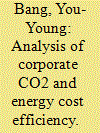

|
|
|
|
|
| Summary/Abstract |
Corporate eco-efficiency should be managed to take environmental responsibility for climate change mitigation. However, firms have difficulty determining what eco-efficiency metric is appropriate, what key performance indicators are to be managed, and what characteristics of environmental reporting are effective for environmental management. Thus, this study develops and measures a corporate CO2 and energy cost efficiency; and analyzes the key performance indicators and industrial characteristics for this cost efficiency and the key characteristics of environmental reporting to effectively enhance the cost efficiency. The cost efficiencies of 119 firms are measured by using a data envelopment analysis (DEA). A statistical Tobit regression analysis is used to analyze the key performance indicators and the characteristics of effective environmental reportings. The cost efficiencies of the firms are overall low and affected by industrial characteristics, i.e., assembly- or process-based manufacturing. The key performance indicators are significantly related with administration cost and energy intensities. The effective environmental reportings have a common characteristic that requires qualitative real evidences for environmental improvement, as well as quantitative environmental performances. This study provides valuable information for corporate environmental management and policy to effectively enhance the eco-efficiency of firms.
|
|
|
|
|
|
|
|
|
|
|
|
|
|
|
|
| 2 |
ID:
094905
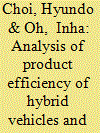

|
|
|
|
|
| Publication |
2010.
|
| Summary/Abstract |
The key aim of this study is to evaluate the product efficiency of current hybrid vehicles and suggest effective policies to promote hybrid vehicles in the Korean automobile market and development trends of hybrid vehicles. The efficiency levels for car models sold in Korea, including hybrid ones, were measured using the recently developed discrete additive data envelopment analysis (DEA) model that reflects consumer preference. The result of the analysis shows that current hybrid vehicles on the market are still at lower competitive advantage than traditional car models with conventional combustion engines and we can suggest a mix of incentive policies to promote the competitiveness of hybrid vehicles. In addition, we also identify two distinctive trends of hybrid vehicle development: environment-oriented hybrid vehicles and performance-oriented hybrid vehicles. It implies that the government should take account of development trends of hybrid vehicles to achieve the policy goals in designing support schemes and automobile companies that are willing to develop hybrid vehicles can also gain some insights for making strategic decisions.
|
|
|
|
|
|
|
|
|
|
|
|
|
|
|
|
| 3 |
ID:
176801
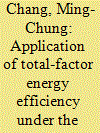

|
|
|
|
|
| Summary/Abstract |
As the computation of total-factor energy efficiency (TFEE) is not workable under the metafrontier framework since the metafrontier cannot fully envelope each group frontier, this research provides a new computation mode to solve this problem. Following a discussion on the methodology, we conduct empirical analysis on 28 member countries in the European Union (EU) and then divide them into Baltic sea region (BSR) countries and non-Baltic sea region (NBSR) countries for metafrontier analysis, thus contributing to the literature by presenting an available mode for TFEE analysis under the metafrontier framework. The suggested mode herein operates so successfully that all computation scores exhibit a reasonable scope. In addition, the BSR's average energy efficiency performs better than NBSR's, but the latter is still a technology exporter compared to the former. This paper summarizes the conditions for sustainable energy development: (i) set more serious energy efficiency targets; (ii) reduce primary and final energy consumptions, lower energy dependence on energy imports, and increase the share of renewable energy sources to fossil fuel energy sources; (iii) achieve a liberalized energy market; and (iv) set reasonable energy prices by levying an energy tax in order to realize effective energy consumption.
|
|
|
|
|
|
|
|
|
|
|
|
|
|
|
|
| 4 |
ID:
113480


|
|
|
|
|
| Publication |
2012.
|
| Summary/Abstract |
According to binding European Union agreements, the Netherlands has to cover at least 14% of its total energy use with renewable energy sources by 2020. However, the share of renewable energy in the Netherlands is small and hardly increasing. In 2010, renewable energy in the Netherlands accounted for only 3.8% of the national energy use, and has decreased with 0.4% compared to 2009. A cause of the stagnating renewable energy generation in the Netherlands is the absence of a nation-wide, clear and consistent long-term policy on the introduction of renewable energy. In order to overcome the current standstill in renewable energy adoption, several Dutch municipalities take the initiative and establish Local Energy Companies (LECs). However, to date, it is unclear which LEC type performs best. This research aims to compare the performance of existing LECs on three aspects: technology, finance, and organization. Furthermore, the performance of existing LECs is compared with theoretical reference LECs, in order to estimate efficiencies and opportunities for improvements. Finally, the influence of the recent changes in the Dutch subsidy scheme on LEC performance is examined. In order to achieve these aims, the benchmark method Data Envelopment Analysis is employed.
|
|
|
|
|
|
|
|
|
|
|
|
|
|
|
|
| 5 |
ID:
103611
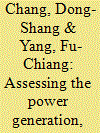

|
|
|
|
|
| Publication |
2011.
|
| Summary/Abstract |
This paper evaluates the productivity of municipal solid waste incinerators (MSWIs) by addressing the following questions: (1) to what extent should one further increase the production of power generation while maintaining the emission of noxious air at the current level?; (2) To what extent should one further decrease the emission of noxious air while maintaining the production of power generation at the current level?; and (3) To what extent should one increase the production of power generation and decrease the emission of noxious air simultaneously? To effectively address these questions to improve performance, the power generation and pollution control efficiencies are evaluated using TODEA (two-objective data envelopment analysis), as well as the overall efficiency evaluated using Tone's NS-overall model (slacks-based measure with non-separable desirable and undesirable outputs for evaluating overall efficiency). A MSWI case study in Taiwan with the panel data covering the period of 2004-2008 reveals that the power generation and overall efficiencies of build-operate-transfer are more efficient, on average, than those of public-own-operate and build-own-operate. However, the three building and operation types do not significantly differ in pollution control efficiency.
|
|
|
|
|
|
|
|
|
|
|
|
|
|
|
|
| 6 |
ID:
098693


|
|
|
|
|
| Publication |
2010.
|
| Summary/Abstract |
In this study, efficiency analyses of the eleven lignite-fired, one hard coal-fired and three natural gas-fired state-owned thermal power plants used for electricity generation were conducted through data envelopment analysis (DEA). Two efficiency indexes, operational and environmental performance, were defined and pursued. In the calculation of the operational performance, main production indicators were used as input, and fuel cost per actual production (Y) was used as output (Model 1). On the other hand, in the calculation of the environmental performance, gases emitted to the environment were used as output (Model 2). Data envelopment analysis (DEA) is the main instrument for the measurement of relative performances of the decision making units with multiple inputs and outputs. Constant returns to scale (CRS or CCR) and variable returns to scale (VRS or BCC) type DEA models were used in the analyses. The relationship between efficiency scores and input/output factors was investigated. Employing the obtained results, the power plants were evaluated with respect to both the cost of electricity generation and the environmental effects.
|
|
|
|
|
|
|
|
|
|
|
|
|
|
|
|
| 7 |
ID:
101086


|
|
|
|
|
| Publication |
2010.
|
| Summary/Abstract |
This paper examines the efficiency of the Thai banking sector from 1999 to 2008 by using the data envelopment analysis (DEA) method. The results indicate that inefficiency in the sector stems mainly from scale rather than pure technical efficiencies. The findings suggest that small banks are most efficient, while medium-sized banks have been the least efficient banking group. Domestic banks have been relatively more efficient than their foreign bank peers, which can be attributed largely to a higher pure technical efficiency (PTE) level. The results from the multivariate regression analysis suggest that banks with higher loans intensity and which are relatively better capitalised tend to exhibit higher efficiency levels. On the other hand, credit risk is negatively related to bank efficiency. The empirical findings suggest that the recent global financial crisis exerts a negative impact on the efficiency of Thai banks.
|
|
|
|
|
|
|
|
|
|
|
|
|
|
|
|
| 8 |
ID:
117348
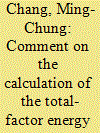

|
|
|
|
|
| Publication |
2013.
|
| Summary/Abstract |
This study provides a no-output growth model to conveniently calculate the total-factor energy efficiency (TFEE) index originally proposed by Hu and Wang (2006). The TFEE index serves as a very well-known and popular means of estimating overall energy efficiency. While many previous studies have used the indicator of energy inefficiency, including the indicator of energy intensity (i.e., Energy input/Gross Domestic Product (GDP)) to measure energy efficiency, Hu and Kao (2007) point out that the indicator of energy intensity is not only a partial-factor energy efficiency indicator, but that this partial-factor ratio is also quite inappropriate for analyzing the impact of changing energy use over time. The TFEE index overcomes the disadvantage of the indicator of energy intensity as mentioned above, but five steps are needed to calculate the TFEE score. In this study, we provide a no-output growth model to conveniently calculate the TFEE score. Furthermore, we extend this no-output growth model to an output growth model. This study concludes that the output growth model not only makes it easier to calculate the TFEE index than the model proposed by Hu and Wang (2006) and Hu and Kao (2007), but that it can also obtain better TFEE scores.
|
|
|
|
|
|
|
|
|
|
|
|
|
|
|
|
| 9 |
ID:
094933
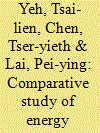

|
|
|
|
|
| Publication |
2010.
|
| Summary/Abstract |
This paper employs data envelopment analysis to evaluate energy utilization efficiency between China and Taiwan from 2002 to 2007. The most important contributions of this paper are the clear description of the systematic process of energy utilization efficiency, the efficiency comparison between China and Taiwan, the remarkable demonstration of their outputs through two non-desirable outputs (CO2 emissions and SO2 emissions) in the data envelopment analysis framework, and the valuable results and insights gained from the application of economic development and environmental protection. Empirical results show that the Eastern region of China enjoy higher energy utilization efficiency than the Western region. Energy utilization efficiency in Taiwan is higher than that in the Eastern region of China. In China, CO2 emissions were 11.28% greater than they should be (from 2002 to 2007). By contrast, CO2 emissions in Taiwan were only 1.50% in excess of what they should be since Taiwan began conducting an uninterrupted energy-saving policy and a CO2 emission regulation policy (Bureau of Energy, Ministry of Economic Affairs, 2009). Finally, this study employs the business strategy matrix constructed by the Boston Consulting Group (BCG Matrix) to illustrate individual evidence of the relationship between economic development efficiency and greenhouse gas efficiency.
|
|
|
|
|
|
|
|
|
|
|
|
|
|
|
|
| 10 |
ID:
090942
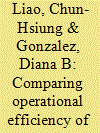

|
|
|
|
|
| Publication |
2009.
|
| Summary/Abstract |
Using partial factor productivity and data envelopment analysis approaches, this study measures and compares the operational efficiency of the 10 dominant mobile operators in Brazil, Russia, India and China (BRIC) between 2002 and 2006. The results of data envelopment analysis indicate that the two leading Brazilian mobile operators, Vivo and TIM, are fully efficient throughout the entire period of study; however, Indian mobile operators are the least efficient among BRIC operators. Interestingly, the findings of this study verify that full operational efficiency can be achieved by operators with large revenues, such as China Unicom, and by others with medium and small revenues, such as Vivo, TIM and Oi. Partial factor productivity demonstrates that 3 of the 4 Brazilian mobile operators, Vivo, TIM and Oi, have remarkable productivity ratios, and that the state-owned operator, China Unicom, has the highest revenue per capital expenditure among BRIC operators. In contrast, Indian mobile operators' productivity ratios are generally low compared to other BRIC mobile carriers.
|
|
|
|
|
|
|
|
|
|
|
|
|
|
|
|
| 11 |
ID:
092726
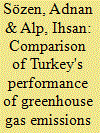

|
|
|
|
|
| Publication |
2009.
|
| Summary/Abstract |
Turkey signed the Kyoto Protocol on February 17th, 2009. Therefore, to fulfill the liabilities of the Kyoto Protocol, she has to review her status and make strategic plans to hold the emissions at the levels specified in the protocol. For this purpose, in this study employing data envelopment analysis (DEA), Turkey's greenhouse gas (GHG) emissions and local/regional pollutants compared to the European Union (EU) countries have been put in place. Since the data on Malta and Cyprus was inadequate, these two nations were excluded from the evaluation. As a candidate for EU, Turkey is required to reduce the emissions by 8% until 2012 within the framework of the Kyoto Protocol.
Two models were considered in this performance work: (i) the first model for the input energy consumption, GHG and local/regional pollutants (total GHG, CO2, F (emissions of non-methane volatile organic compounds), CO, NO2, SO2) has been considered as the output value. (ii) In the second model, the values entered in the sectoral energy consumption have been considered as GHG emissions and local/regional pollutants output. Model 2 was taken into account in which different inputs were employed to observe the impacts of input values causing GHG emissions on emission. DEA technique is used, which holds the output constant in the direction which should reduce the input. For this purpose, the effect of sectoral energy consumption on total emission was identified and it was aimed to identify on which energy resources the strategy developed for emission reduction should be.
|
|
|
|
|
|
|
|
|
|
|
|
|
|
|
|
| 12 |
ID:
111348
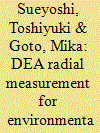

|
|
|
|
|
| Publication |
2012.
|
| Summary/Abstract |
Energy policy depends on a proper use of methodology in guiding a large energy issue such as the global warming and climate change. DEA is one of such methodologies that are often used for preparing environmental policy, which is closely linked to various energy issues. Unfortunately, the use of DEA applied to environmental policy is insufficient, often misguiding policy makers and other individuals who are involved in energy issues. This study provides three guidelines for a use of DEA in preparing environmental assessment. First, it is important to prepare both primal and dual formulations to confirm whether information regarding all production factors (i.e., inputs, desirable and undesirable outputs) is fully utilized in DEA assessment. Second, DEA has model variations in radial and non-radial measurements. It is necessary for us to examine environmental issues by different models in order to avoid a methodological bias existing in those empirical studies. Finally, DEA environmental assessment needs to incorporate the concept of natural and managerial disposability. The natural disposability indicates that a firm negatively adapts a regulation change on undesirable outputs. In contrast, the managerial disposability indicates that a firm positively adapts the regulation change because the firm considers the regulation change as a new business opportunity.
|
|
|
|
|
|
|
|
|
|
|
|
|
|
|
|
| 13 |
ID:
122742
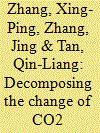

|
|
|
|
|
| Publication |
2013.
|
| Summary/Abstract |
This paper presents an alternative decomposition method to explore the driving forces of change in carbon emissions by using distance functions estimated by data envelopment analysis. The proposed approach can isolate the effects of changes in GDP composition and energy supply composition on the change of carbon emissions. In addition, it is capable of identifying the effects of changes in different input ratios, which may be very important if there are substitution effects among different inputs. Moreover, the proposed model can measure the effects of changes in good and bad output technical efficiencies. Consequently, this decomposition technique allows a change of carbon emissions to be decomposed into contributions from ten factors, which provides more insights for policy makers. We apply this model to decompose carbon emissions in 25 OECD counties and China. For the sample countries as a whole, the empirical results indicate that the economic growth is the crucial driver to carbon emissions increase, while the changes in GDP composition and capital-energy ratio are two main drivers to carbon emissions reduction. In particular, we discuss in detail the driving forces of China's carbon emissions change in order to propose some valuable policy implications for China from an international perspective.
|
|
|
|
|
|
|
|
|
|
|
|
|
|
|
|
| 14 |
ID:
098681


|
|
|
|
|
| Publication |
2010.
|
| Summary/Abstract |
Energy use in the production of desirable output often results in the generation of undesirable emission with detrimental impact on the environment, and whose disposal is frequently monitored by public authorities. Previous studies, however, paid little attention to undesirable output and environmental regulation related to its disposal while estimating energy use efficiency. Analysis of energy efficiency ignoring undesirable output could result in biased estimates of efficiency. Thus the aim of this paper is to estimate energy use efficiency in the presence of energy related undesirable emission by taking Indian cement industry as a suitable context of my analysis. Depending on the presence and absence of undesirable output and environmental regulation, three measures of efficiency have been estimated at the state level from 2000-01 to 2004-05 by applying Data Envelopment Analysis. Energy efficiency is defined as the ability of the producer to reduce the energy input to the largest extent possible, conditional on the given level of output and non-energy inputs. Empirical results reveal that energy efficiency estimates are biased if only desirable output is considered. Results also demonstrate that environmental regulation has a reinforcing effect on energy use efficiency.
|
|
|
|
|
|
|
|
|
|
|
|
|
|
|
|
| 15 |
ID:
092766


|
|
|
|
|
| Publication |
2009.
|
| Summary/Abstract |
This research examines the effect of air quality regulations on the productivity of US power plants based on both economic and environmental outputs. Using data envelopment analysis (DEA) to estimate an efficiency measure incorporating both economic and environmental outcomes, we look at changes in efficiency in US power plants over an eleven-year time period (1994-2004) during which several different regulations were implemented for the control of nitrogen oxides (NOx) and sulfur dioxide (SO2). The paper then models how estimated efficiency behaves over time as a function of regulatory changes. Findings suggest mixed effects of regulations on power plant efficiency when pollution abatement and electricity generation are both included as outputs.
|
|
|
|
|
|
|
|
|
|
|
|
|
|
|
|
| 16 |
ID:
104965
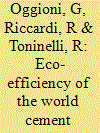

|
|
|
|
|
| Publication |
2011.
|
| Summary/Abstract |
Chemical reactions and the combustion of dirty fuels, such as coal and petroleum coke (petcoke), that are used in cement production processes generate a significant amount of CO2 emissions. In this paper, we provide an eco-efficiency measure for 21 prototypes of cement industries operating in many countries by applying both a data envelopment analysis (DEA) and a directional distance function approach, which are particularly suitable for models where several production inputs and desirable and undesirable outputs are taken into account. To understand whether this eco-efficiency is due to a rational utilization of inputs or to a real carbon dioxide reduction as a consequence of environmental regulation, we analyze the cases where CO2 emissions can either be considered as an input or as an undesirable output. Empirical results show that countries where cement industries invest in technologically advanced kilns and adopt alternative fuels and raw materials in their production processes are eco-efficient. This gives a comparative advantage to emerging countries, such as India and China, which are incentivized to modernize their production processes.
|
|
|
|
|
|
|
|
|
|
|
|
|
|
|
|
| 17 |
ID:
112890
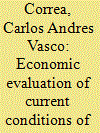

|
|
|
|
|
| Publication |
2012.
|
| Summary/Abstract |
This study uses microeconomic data from the transportation systems of land cargo in Colombia: rail and trucking, to determine their degree of allocative efficiency through the non-parametric method Data Envelopment Analysis DEA. The average overall efficiency found was 74.4% for trains and 20.56% for trucks. These figures indicate that rail is more efficient in the allocation of resources. This means that trains in Colombia use their input better than trucks to maximize their production, given the costs and technological characteristics of each system. This is a signal for the design of a public policy for investment in transportation infrastructure that seeks to raise the competitiveness of Colombian exports, investing not only in roads but in complementary systems such as railways too.
|
|
|
|
|
|
|
|
|
|
|
|
|
|
|
|
| 18 |
ID:
103415
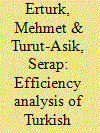

|
|
|
|
|
| Publication |
2011.
|
| Summary/Abstract |
This paper analyzes the performance of 38 Turkish natural gas distribution companies by using a non-parametric method, Data Envelopment Analysis (DEA). The results are used to determine the most proper model specification, to detect the important criteria affecting the efficiency levels, and to find the common characteristics of the most inefficient firms. We find that public firms compared to private firms, non-tender firms compared to tender firms, large firms compared to small firms and firms operating in more developed areas compared to firms operating in underdeveloped areas that utilize resources and manage costs more efficiently. However, we cannot reach a certain conclusion about the comparison of old firms versus the new firms. Lastly, we try to detect the common characteristics of the most inefficient firms and find that most of these firms are immature and low scale companies. Therefore, we think these firms can increase efficiency level either by increasing their delivery amounts through higher penetration rates or by merging or doing both together.
|
|
|
|
|
|
|
|
|
|
|
|
|
|
|
|
| 19 |
ID:
112297
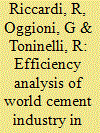

|
|
|
|
|
| Publication |
2012.
|
| Summary/Abstract |
CO2 emissions reduction and energy efficiency improvement are the targets of many environmental policies that aim at tackling climate change. The European Emission Trading is the best example of this engagement against climate change. Considering this framework, this paper studies the efficiency of the high energetic and CO2 emissions intensive cement production process in 21 world countries. Alternative formulations of standard data envelopment analysis models and a directional distance function approach are compared in order to detect the efficiency of the cement sector both in presence and in absence of carbon emissions. We first analyze the entire cement production process and we then concentrate on the production of clinker, a by-product of cement, that is the main responsible of CO2 emissions. Our results show that the inclusion or the exclusion of undesirable factors (CO2) influence efficiency levels as well as the investments in new technologies and the utilization of alternative fuels and raw materials in the cement and clinker production processes.
|
|
|
|
|
|
|
|
|
|
|
|
|
|
|
|
| 20 |
ID:
157667


|
|
|
|
|
| Summary/Abstract |
The study determines the efficiency of Indian pharmaceutical firms and its determinants in the pre- and post-product patent regime. Overall inefficiency in the industry is higher due to the inefficient conversion of inputs into output rather than through scale inefficiency. The study finds that the Product Patent Act has a negative impact on efficiency. Ownership, capital imports intensity and size variables are positively related with efficiency scores whereas age, time dummy and size square variables are inversely related. The study supports the finding that with an increase in mergers and acquisitions, a movement towards diversifying operations, the use of advanced imported foreign technology, investment in fixed assets and judicious allocation of resources for marketing activities could improve firm performance. For future policy implications, the small firms may either merge into bigger entities or manufacture pharmaceutical products for other companies, so as to raise operational scale and improve capacity utilisation.
|
|
|
|
|
|
|
|
|
|
|
|
|
|
|
|
|
|
|
|
|